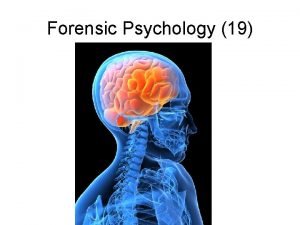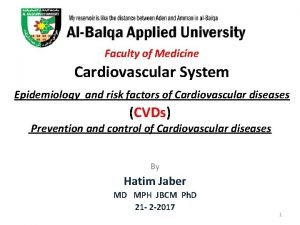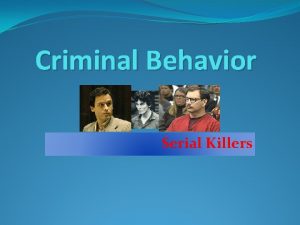Introduction to Serial Killers Characteristics WHAT IS A












![Most frequently selected victims [Hickey (2002; 399 serial killers)] Strangers (70%) 1. College students, Most frequently selected victims [Hickey (2002; 399 serial killers)] Strangers (70%) 1. College students,](https://slidetodoc.com/presentation_image_h2/54a49a52039b9f4dbcd26220e3fae2a8/image-13.jpg)







- Slides: 20

Introduction to Serial Killers

Characteristics WHAT IS A SERIAL KILLER? • Has committed more than 3 murders • Murders committed over a short period of time • Very cautious about their murders • In between their crimes, they appear to be quite normal, a state which has been called the "mask of sanity. " COMMON MISCONCEPTIONS • Social misfits, dysfunctional or “loners” • Have no social control • Are “evil geniuses” or insane • Always white male

Top 10 Most Common Traits � 10 – Alcohol and substance abuse � 9 – Psychological abuse during childhood � 8 – Sexually stressful events in childhood � 7 – Bedwetting � 6 – Growing up lonely and isolated � 5 – Fantasies � 4 – Preferring alone activities � 3 – Voyeurism in adulthood � 2 – Acting out fantasies on animals � 1 – Physical injuries (often head trauma)

Most Common Profile �Mostly white males with average intelligence, average is 29 �Usually from unstable home �Absence of a loving and nurturing relationship �Physical ailments or disabilities (head injuries common) �Triad – Animal Cruelty, Bedwetting, Pyromania

The Mc. Donald Triad Animal Cruelty, Bedwetting, Pyromania �Animal Cruelty – Practice torture techniques on animals before moving onto humans. Dahmer often mutilated and tortured stray dogs �Bed-wetting – 60% of serial killers wet their bed AFTER adolescence �Pyromania – Destruction is exciting. Easy to make leap from destruction of property to destruction of human lives.

Categorizing the Serial Killer • sex, race, age • IQ • psychopathology • Crime Scene • • type of weapon use of torture attempt to hide body location • Motive • sex • power • financial gain • Victim • sex, race, age • occupation • personality

Organized vs. Disorganized • The FBI classified serial killers into 3 large groups: • Disorganized • Organized • Mixed • Serial killers can evolve from organized into disorganized

The Crime Scene • Crime Characteristic • Body • Weapons • Viciousness • Sophistication • Totem Disorganized disfigured finds at scene torture low not taken • Follows crime in news no • Victim high risk • Gets to crime by walking, bus Organized hidden brings quick high, learns each time taken yes low risk drives

Killer Profile • Characteristic Disorganized Organized • Residence close to crime further • IQ less intelligent • Employment menial/unemployed normal • Appearance unattractive • Self-image feels inferior feels superior • Social loner outgoing • Romance lives alone affairs, short relationships • Anger keeps inside acts out, bully, class clown • Birth order youngest oldest • Childhood discipline harsh lax or inconsistent

MOs and Signatures Modus Operandi refers to common aspects of the criminals activities that might change according to circumstances (e. g. , means of access, availability of weapons). Signatures are unique and stable, revealing psychological needs (e. g. , ritual aspects of crime, nicknames, posing the corpse, inserting objects). Latter more useful for linkage analysis – determining if same individual is responsible for various crimes. Death tarot card left at various murder scenes from the DC Snipers

Souvenirs and Trophies • Serial killers often keep mementos of their victims. • Souvenirs: Personal items allow the killer to enjoy the memories • A trophy can become something of a shrine Facemasks kept by Ed Gein Skulls kept by Dahmer after cannibalization

Geographic Areas • Most murders take place within one mile of the offender’s home • However, there is a buffer zone as killers don’t want to attack too close to their own home • adult offenders tend to travel further than do juvenile offenders; • robbers tend to travel longer distances than do burglars; • body dumpsites tend to be further from the killer's residence than from the sites they meet their victims
![Most frequently selected victims Hickey 2002 399 serial killers Strangers 70 1 College students Most frequently selected victims [Hickey (2002; 399 serial killers)] Strangers (70%) 1. College students,](https://slidetodoc.com/presentation_image_h2/54a49a52039b9f4dbcd26220e3fae2a8/image-13.jpg)
Most frequently selected victims [Hickey (2002; 399 serial killers)] Strangers (70%) 1. College students, prostitutes 2. Little boys and girls 3. Hitchhikers 4. People at home 5. Handicapped people 6. Store-owners, landlords 7. People walking street 8. Older women 9. Police officers 10. Derelicts/transients 11. People responding to newspaper ads Acquaintances (20%) 1. Friends and neighbours 2. Girlfriends and boyfriends 3. Waitresses and prostitutes 4. Co-workers 5. Landlords, employers, guards 6. Gang members 7. Patients Family (10%) 1. Own children 2. Husbands 3. Wives 4. In-laws 5. Nephews, nieces 6. Own mother 7. Sibling 8. Grandparents

Methods & Motives for Males Methods • 1. Firearms mainly (41%) • 2. Suffocation (37%) • 3. Stabbing (34%) • 4. Bludgeoning (26%) • 5. Firearms only (19%) • 6. Poison (11%) • 7. Drowning (3%) • 8. Other (2%) Motives • 1. Lust (55%) • 2. Control (29%) • 3. Money (19%) • 4. Enjoyment (16%) • 5. Racism and hatred (11%) • 6. Mental problems (6%) • 7. Cult-inspired (5%) • 8. Attention (2%)

Female Serial Killers Tend to use poison, kill those close to them and profit or “mercy” is the motive. • Black Widows – kill husbands for inheritance or insurance. • Angels of Death – often health professionals who kill “because they can” or out of a sense of mercy. • Folie a deux – women who engage in lust killing usually do so in tandem with a male partner (e. g. Myra Hindley, Rose West).

Female Serial Killers: Methods & Motives Methods • 1. Poison (80%) • 2. Shooting (20%) • 3. Bludgeoning (16%) • 4. Suffocation (16%) • 5. Stabbing (11%) • 6. Drowning (5%) Motives • 1. Money (74%) • 2. Control (13%) • 3. Enjoyment (11%) • 4. Sex (10%) • 5. Drugs, cult involvement, cover up, or feelings of inadequacy (24%)

Gender Changes Across Time U. S. & International Serial Killers Decade Men Women 2010 94. 4% 5. 6% 2000 91. 4% 8. 6% 1990 93. 0% 7. 0% 1980 93. 0% 7. 0% 1970 94. 5% 5. 5% 1960 92. 3% 7. 7% 1950 85. 9% 14. 1% 1940 88. 3% 11. 7% 1930 84. 1% 15. 9% 1920 79. 4% 20. 6% 1910 74. 0% 26. 0% 1900 59. 4% 40. 6% TOTAL 90. 8% 9. 2%

U. S. Serial Killers by Decade (Decade of First Kill)

Why the decrease in the U. S. ? • Technology • Insurance fraud is more difficult • Killing multiple patients is not likely to go unnoticed • Longer prison sentences keep potential serial killers in prison • Law enforcement efforts • Catch single murder more quickly (e. g. , DNA) • Efforts on terrorism reduce the FBI’s ability to link serial murders • Fewer available victims

Fewer Targets: We Have Changed our Behavior • Hitchhiking Related • Hitchhiking • Offering rides • Accepting an offer to “get in” • Disabled Motorists • Offering assistance • Accepting assistance • Free-Range Kid Behavior • Walking to/from school or the store • Riding bicycles • Playing in the park • Fishing and hiking alone
 Black widow vs angel of death
Black widow vs angel of death Pacific northwest serial killers
Pacific northwest serial killers Fritz haarmann childhood
Fritz haarmann childhood Forensic psychology serial killers
Forensic psychology serial killers Forensic psychology serial killers
Forensic psychology serial killers Thesis statement about serial killers
Thesis statement about serial killers Different types of serial killers
Different types of serial killers Serial killers forensic psychology
Serial killers forensic psychology Russell odom and clay lawson
Russell odom and clay lawson Organized vs disorganized serial killers
Organized vs disorganized serial killers Serial killer bedwetting
Serial killer bedwetting Serial killers facts
Serial killers facts Joseph kallinger
Joseph kallinger Pierce serial killer
Pierce serial killer Albert fish's letter
Albert fish's letter Serial killers forensic psychology
Serial killers forensic psychology Pipo truth table
Pipo truth table What is soap opera
What is soap opera The killers cousin
The killers cousin Catching killers fire investigation
Catching killers fire investigation Heart disease and stroke are the world's biggest killers
Heart disease and stroke are the world's biggest killers




































